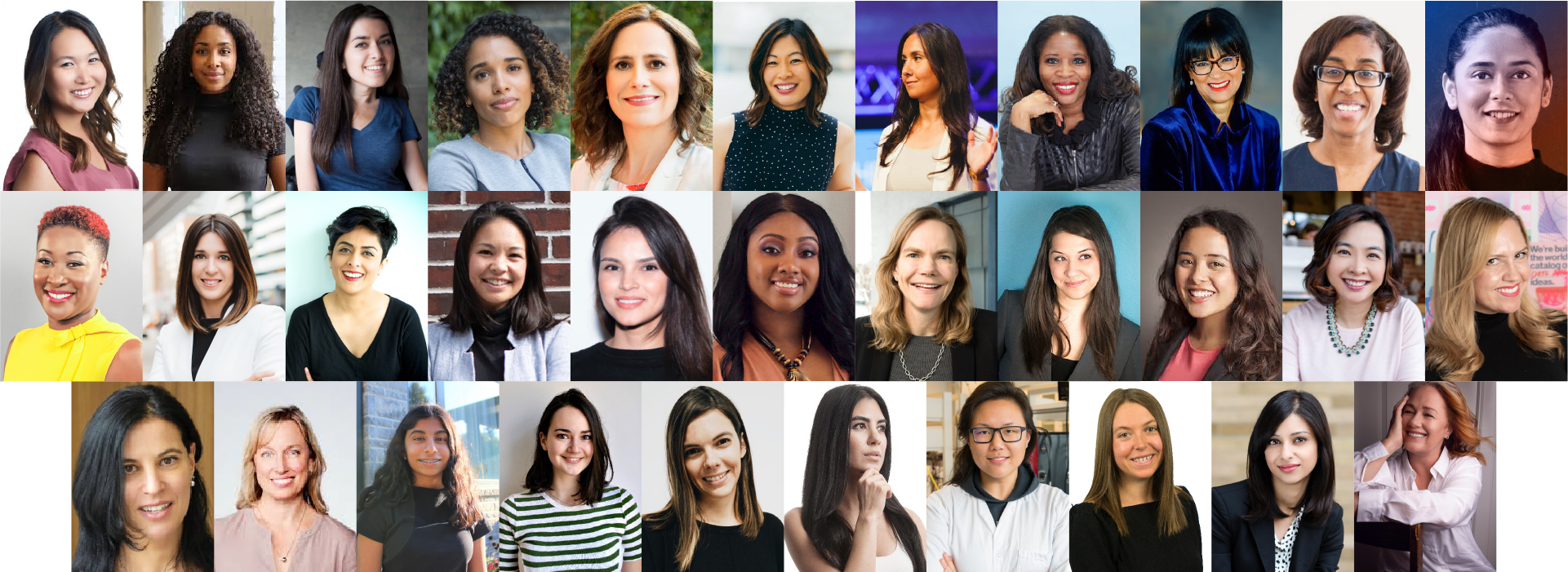Category Archives: Blog Categories
Elevating our Black Founders
Get to know Black Founders making their mark in the tech startup ecosystem.
As much as we would have loved to feature ALL of our innovative and determined Black Founders, this list profiles a handful of them. Learn more about our Black Innovation Programs, and how the DMZ is empowering the next wave of Black entrepreneurs here.
Black founders are often faced with various hurdles when starting and growing a new business venture, which has led to a massive underrepresentation of Black leaders in the tech ecosystem. Black founders have never lacked the talent or ability needed to secure funding opportunities; they lack access to those opportunities: access to mentorship, learning opportunities and capital.
Recognizing this opportunity gap in support for Black founders, the DMZ launched the Black Innovation Programs in 2019 to make an impact, see growth in the number of companies that are owned by Black entrepreneurs, and break the perpetual cycle of inequity.
In light of Black History Month, the DMZ wanted to highlight some of our innovative entrepreneurs from our Black Innovation Programs. Sharing personal insights, lessons learned from their entrepreneurial journey, and the inspiration behind their organizations, these trailblazers are spinning the wheels of change.

Peter Odle
Founder at Urban Expeditions
Urban Expeditions creates customizable walking tours and games that leverages technology to strengthen an individual’s cultural connection to a city.
What has been the greatest lesson you learned since your startup journey?
“My greatest lesson on the start-up journey has been to seek harmony amidst the loneliness of entrepreneurship, the passion to create, a focused ambition and building relationships with people who can help me manage my appetite for risk.”
@urbanexpeditions

Nadiya Ali
Founder and CEO at Kynza
Kynza offers an end-to-end management solution for the contemporary rotating savings user, allowing users to take charge of their financial future.
If you had one piece to your younger self, what advice would that be?
“Relationships are the wellspring of great ideas – so value and nurture your network!”
@Kynza.group
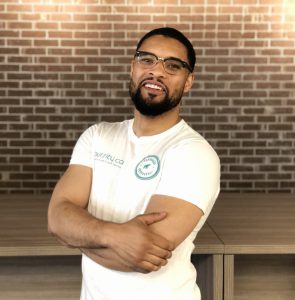
Charles F Milton
Founder and CEO at Bursity.org
For marginalized students, Bursity is the fastest way to fund tuition, connecting students with millions of dollars in financial awards, and helping scholarship sponsors streamline their awards campaigns.
What have you achieved since beginning your journey in the DMZ?
‘Since starting DMZ’s program, we have had over 100 new users sign up to our MVP platform, which launched in August 2020. That makes us one third of all of our current users.”

Ogochukwu Anerobi
Co-Founder and CEO at Learndeck
LearnDeck is a cloud-based learning management system that allows users to deploy and track online training courses and programs without geographical limitations.
What have you achieved since beginning your journey in the DMZ?
“My monthly recurring revenue (MRR) has grown by 110% since I joined the DMZ!”
@thelearndeck

Tunde Omotoye
Founder and CEO at HumanSquad
HumanSquad helps people navigate their immigration journey and career path. They do this through a portfolio of services that include HR consultancy, personal branding, and Canada immigration processes.
Why did you start your company?
“There are many people looking to move to Canada but are prone to being defrauded by roadside agents in their respective countries. We created HumanSquad to bridge the gap between respective immigrants and RCICs (regulated Canadian immigration consultants) in Canada. Hence, our start-up tends to help people navigate the often complex immigration pathways by using technology to connect them to licensed experts from the comfort of their homes.”
@humansquadca

Deinyefa Eporwei
Co-Founder and CEO of Solooble
Solooble is making financial wellness available and affordable for all through a tool that monitors the financial health of its users. It tracks users’ spending trends, provides feedback and pays bills.
What has been the greatest lesson you learned since your startup journey?
“Nothing good in life ever comes easy.”
@solooble
 Nathan Dumont
Nathan Dumont
Founder at Wealthier
Wealthier helps Canadians build healthy financial habits. It offers a unique and sustainable solution that promotes prosperity by ensuring quality education, reducing inequality and poverty.
If you had one piece to your younger self, what advice would that be?
“Start now. Write a small plan and take action.”
@mywealthmatters

Elizabeth Azuya
Founder at Fabbulist
Fabbulist is on a mission to help melanin women find beauty stylists that get their hair type and skin tone. It’s a marketplace that allows users to find and book black beauty stylists near them, or become a stylist and earn money on their own schedule.
What has been the greatest lesson you learned since your startup journey?
“Taking a step, no matter how small, each day towards moving your idea adds up to big results over time.”
@fabbulist_
Make sure to check out our social channels for even more spotlights on our Black Founders, and find out more about our Black Innovation Programs here!
How digital badging gives young professionals a competitive edge
Jumpstarting students’ career paths in cybersecurity with CanHack digital badges
It’s not too late for high school students to register for CanHack 2021 and compete for up to $16,250 in prizes! Learn more here.

As the years pass in a student’s journey through education, they will tackle many great accomplishments: from academic achievements, participation in extracurriculars, competitions, volunteer and community work, involvement in student associations, and so on. Previously, certificates, diplomas, badges and trophies have typically represented tokens of these achievements.
Now, with the global workforce becoming increasingly digital, students need a new way to display these accomplishments. Furthermore, COVID-19 has forced education institutions to rapidly shift to online learning, meaning physical certificates often can’t be provided to add to student portfolios. How do these accomplishments get recognized?
There’s a better way for students to present these achievements: digital badging.
What is digital badging?
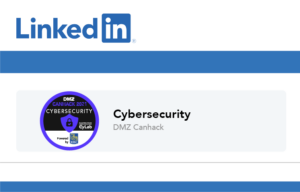 Simply put, digital badging, also known as digital credentials and micro credentials, is a validated online certification of a specific accomplishment or skill. Digital badging provides learners with a bite-sized approach to education, and focuses on the development of a specific skill. When a learner completes a new course or gains a new skill, they receive a digital badge as recognition for their achievement. Unlike physical certificates, badges are designed to be optimized for sharing on social media and professional networks like LinkedIn to help individuals find a job or earn an internal promotion. When an employer or recruiter sees that a potential job candidate has digital badges listed on their LinkedIn profile, it’s a quick and secure way for the employer to understand the certifications and skills the candidate has.
Simply put, digital badging, also known as digital credentials and micro credentials, is a validated online certification of a specific accomplishment or skill. Digital badging provides learners with a bite-sized approach to education, and focuses on the development of a specific skill. When a learner completes a new course or gains a new skill, they receive a digital badge as recognition for their achievement. Unlike physical certificates, badges are designed to be optimized for sharing on social media and professional networks like LinkedIn to help individuals find a job or earn an internal promotion. When an employer or recruiter sees that a potential job candidate has digital badges listed on their LinkedIn profile, it’s a quick and secure way for the employer to understand the certifications and skills the candidate has.
Digital badge benefits: The learner
It is clear that lifelong learning has become an imperative for young professionals to break into today’s rapidly changing workforce. Up-skilling and re-skilling allows professionals (of all ages) to remain relevant and up to speed on the latest trends. Digital badges helps learners:
- Become motivated to grow their careers by learning new skills outside of what they have been taught in school.
- Finesse their own personal brand image and improve their competitiveness in the job market by highlighting badges on social media platforms like LinkedIn.
- Showcase their soft skills and bridge any skills gap that may exist between academic achievements and job requirements.
- Demonstrate to future employers their eagerness and ability to acquire new skills.
CanHack introduces digital badging
At the DMZ, we believe it is crucial to empower Canada’s next generation of innovators and provide them with the necessary skill sets to thrive. As the skills gap in cybersecurity widens, we hope to promote cyber literacy while getting students excited about a potential career in the space. We will provide every participant a digital badge, marking their official participation in the third annual CanHack challenge (bragging rights included)! CanHack participants will be able to send a signal of great success to post secondary institutions and future employers, as CanHack’s digital badge will give them a competitive edge. All CanHack badges are endorsed by cybersecurity leaders, Carnegie Mellon University Cylab Security and Privacy Institute and RBC, helping students to stand out!
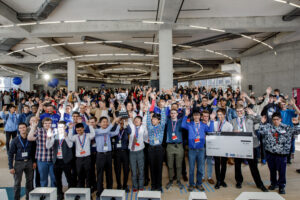
About CanHack
The DMZ at Toronto Metropolitan University, in partnership with the Royal Bank of Canada, have come together to launch CanHack – a cybersecurity student competition to promote cyber literacy and to also address digital skills gaps in the labour market. Participants will learn critical computer security skills, work with experts in the field and have an opportunity to win up to $16,250 in cash prizes for both themselves and the school they attend! CanHack leverages an online open-source computer security platform established by the Carnegie Mellon University Cylab Security & Privacy Institute called PicoCTF. This game-based learning experience creates an interactive and engaging experience where students are tasked with addressing cybersecurity challenges faced by Canadian financial institutions.
Want to learn more about the CanHack challenge and how you can participate? Check out our CanHack page for more information!
DMZ’s holiday gift guide: 8 unique ideas you haven’t thought of yet
Still working through your holiday shopping list? Stuck on deciding what to give your loved ones this holiday season? We’ve rounded up a collection of one-of-a-kind gifts for every person on your list.
Here are 8 unique gift ideas you probably haven’t thought of yet.
For the interior design enthusiast

Give the gift of interior design and help someone experience the luxury of having their space professionally designed.
Daakor’s experts in interior design are passionate about helping clients turn their visions for their home into a reality. From start to finish, Daakor’s interior design is personalized to your tastes, time and budget.
Give a Daakor Design Plan to help your loved one take out the hassle of furnishing their home and help them create a space that looks and feels like a sanctuary.
For the foodie or dinner party host

From deluxe charcuterie baskets filled with gourmet goodies to smaller baskets filled with sweet and savoury snacks, FreshSpoke has curated delicious gift baskets at a variety of price points.
Best of all, FreshSpoke’s products are all made locally, so you can spread joy while supporting farmers and food artisans. These gift options are wonderful corporate gifting ideas but also great for friends and family. Gift cards are also available in any denomination.
For the news buff
If you have that friend or family member who is constantly keeping tabs on the news, gets sucked into polarized politics or is an avid follower of conspiracy theories, the Ground News Premium plan is for them.
Ground News has tools that enable you to objectively see the political coverage bias of any story on the internet, and easily access a myriad of different perspectives on that very same story.

Ground News is unveiling its new and most comprehensive package, the Premium plan. With the Premium plan, you or your loved ones can identify bias in the news (whether you read it in-app, online or on your Twitter feed) and get a balanced all-sides view of the news.
For the content creator or music lover

Staats makes personalized Spotify and Apple Music song plaques and Creator Awards – perfect gifts for music lovers, budding content creators, and loved ones.
The company’s journey started on the App Store building a custom trading card maker, and along the way they developed some amazing products to share with the world. These gifts have become viral trends! Today, in the Staats app, users can customize these items and purchase them, but the company also sells them separately on Etsy.
The gift that gives back

Rumie is changing lives just 10 minutes at a time. One in six young people are unemployed as a result of COVID-19. Rumie aims to replace the time youth spend on social media each day with an engaging learning platform that delivers transferable life and career skills.
This holiday season, donate on behalf of a friend, colleague, or family and give a gift to a whole world of young learners. A donation will contribute to Rumie’s 2021 goals: Create 250 Bytes, fill 1 million jobs, and reach 1 million youth.
For the sentimental friend

When people receive a surprise group video gift, they universally love it, and are often drawn to tears. However, there’s a lot of effort and technical skills involved to create one.
Celebrate makes it easy for anyone to create, collect and share a group video. The app guides the users through the entire process, giving them easy-to-use editing tools, avoiding much of the complexity of full-featured general purpose editing apps.
Key features of Celebrate include an invitation wizard guiding users to create a compelling request that includes video, text, suggested topics, and due date, and an Editing Suite to add text, music, GIFs, cards, pictures and do basic editing.
For the homeowner

Think Uber, but for snow removal! LocalStudent is an online platform that connects customers to students that can help with various services, changing the way that students find work.
This winter, LocalStudent is offering on-demand snow removal. Support students looking for work while giving your loved one the ability to sleep in and skip shovelling the driveway on cold winter mornings.
Buy a gift card or get a free quote today at localstudent.ca.
For the best (worst!) dressed

Want an effortless way to get a man a perfect gift? Get him a gift card. Mannr is a luxury personal styling and delivery service for men. Mannr allows users to conveniently shop with the help of a dedicated professional stylist and get personalized options available from any brand.
This holiday season, Mannr’s has an exclusive offer for gift cards: buy a $300 gift card and get $350 worth of services, or buy a $500 gift card and get $600 worth of services.
![]()
Are you a DMZ member with a product that makes a great holiday gift? Let us know and we’ll add you to our gift guide.
Dream of getting acquired one day? Get first-hand insights from a founder who’s done it
Derek Hopfner, DMZ alum and Co-Founder of Founded, gives an inside scoop on the motivation behind building the startup and getting acquired, along with advice founders should consider to achieve a successful exit someday.
When Founded launched in 2017, co-founders Derek Hopfner, Shane Murphy and Travis Houlette were driven by the company’s mission to make the legal side of business an effortless experience for entrepreneurs.
Within a few short years, thousands of dedicated business users joined Founded. Fast forward to this year: the company made the announcement that they had been acquired by RBC Ventures!
In the coming months, the platform will merge with Ownr, RBC’s existing platform for small business incorporation – but the whole Founded team is staying intact and moving under the RBC Ventures umbrella, together.
Getting acquired is what many young startups hope and dream for one day, but many overlook the meticulous planning and strategic considerations that need to happen at an early stage. We spoke with Derek Hopfner about the experience of scaling Founded, and what startup founders can do early on to position themselves for a successful exit.
Take a look at our Q&A with Derek to hear what he had to say.

What does Founded do?
Founded is an online legal platform with a focus on making entrepreneurship easy. When starting a business, there is an endless number of things that entrepreneurs need to think about early on, so taking away the legal components and making it really simple for them was something that was really important to us.
An entrepreneur can join Founded (soon to be Ownr) and can use the platform to navigate various legal tasks as their company grows. This includes anything from preparing an employment agreement for a new employee to creating website terms of use and privacy policy. You can even create an employee stock option plan, something that’s gaining popularity from startups.
 It sounds like the platform is valuable to companies at all stages of growth, not only young startups looking to get incorporated?
It sounds like the platform is valuable to companies at all stages of growth, not only young startups looking to get incorporated?
That’s true! Many entrepreneurs start their company on Founded, but we also bring on companies that have incorporated elsewhere and want to benefit from using Founded’s technology for legal work going forward.
A nice way to think of it: there are a lot of programs in the accounting field, like Quickbooks, that help entrepreneurs with the accounting side of things. Founded is like that, but for the legal side of things.
What was the motivation behind creating Founded? Were you ever an entrepreneur who experienced similar challenges with getting legal support?
I’m a former lawyer, so I actually saw it from the other side where I did a lot of corporate commercial work with businesses. Oftentimes, legal work was expensive for startups or they saw it as complicated. They didn’t want to meet in a lawyer’s office – they wanted to do things electronically, quickly and seamlessly.
Two out of the three of our founders are lawyers: myself and Shane. Travis is our CTO and Head of Product, and he had the experience from an entrepreneur’s standpoint. Shane and I saw the problems through a lawyer’s lens. We’ve got a good combo between the three of us!

What was the process of scaling the company? Did you have a funding strategy?
We launched in October 2017, so we were in operation for about three years before getting acquired.
We were really lean on funding. We had some angels that supported us but never completed an institutional round of venture capital funding. We also had support from the Ontario Centre of Excellence and government programs like IRAP.
We grew our sales and revenue and always reinvested it back into the company. That meant hiring for sales, marketing, developers – but we have always had a lean team.
Our primary marketing strategy involved using Google Ads, high-quality blog content, and partnering with local entrepreneurship centres like the DMZ, MaRS and Enterprise Toronto. That’s really what allowed us to scale.
We also had a really strong product, so word of mouth helped a lot. People would use the platform, have a great experience, and go on to encourage their friends to use it.
How did joining the DMZ help Founded?
During our time at the DMZ, the company got to a profitable state, which allowed us to continue growing without having to rely on funding.
There are two big things in particular that come to mind that allowed us to do this: we gained a stronger understanding of how to accelerate our sales processes, and learned how to read and analyze our data to then base our strategy around it.
Everything was super helpful – marketing was great, product was great, the programming was really holistic.
Many founders’ biggest dream is to get acquired and get that big exit. Was getting acquired a goal you were working towards from the early days?
It wasn’t necessarily the goal. When we started the company, we were really driven to make entrepreneurship easy.
When you decide to take money from funders, you have to realize they’re not doing it purely to support you and your goal to build a company – they do expect some sort of return to the investment that they’re making. I think most entrepreneurs realize there needs to be some thought towards an exit strategy.
We had been working with RBC for two years. It was never our goal to get acquired at this exact time – it was pretty organic.
I think it’s helpful to start thinking about it early on when starting a company. That being said, if you were to ask me five years ago if the largest bank in Canada were to acquire a legal technology company, I would have never imagined that!
What advice would you give a founder that is interested in getting acquired? What are some important things a founder should consider?
It’s important to understand, early on, what the implications are if you’re taking funding, especially from VCs. Understand how dilution works. Angels are one form of funding, but once you move to institutional funding, there are strong expectations for returns on their investments – to the tune of 10, 15 or even 20 times the initial investment. You need to find a path to hit those metrics.
Next, in the early stages of building a company, take a look beforehand at the exit opportunities that may exist in your particular industry. It’s not a bad idea to look at each industry and understand the valuation multiples which exist. In most cases, you’re putting your whole life into your business – likely a lot of financial resources. So, if you have two choices that you’re equally passionate about, why not go with the industry that has a multiple exit of traditionally 15x revenue, versus another that might only be 2x or 3x.
Now that you’ve gone through most of the acquisition process, do you have any important lessons learned to share with other founders?
Be open to business opportunities as you are growing the company because you don’t know where they’re going to lead. I don’t think it was really on our radar that RBC was going to be our acquirer when we started working with them a couple of years ago, but that turned into something real this year. Where you start with a company is not where you’re going to end up, and I think being open and fluid about that is important.
If you’re having discussions about an acquisition, it’s going to take a lot of your time – a lot more than you’d think. It’s so important to make sure your team is still focused on delivering value each day with the acknowledgement that this acquisition might not go ahead.
Also, don’t put 100% of your time and efforts into the acquisition, or you’ll leave your business behind. You need to continue to drive value to your customers and keep building a strong business. That’s really the best counterpoint to any negotiation. If things fall through, you can then walk away at any time and continue pursuing your business.

When should a founder communicate with their team that an acquisition could be in the works?
I think it depends on the team and its size. Because of COVID and everything that was going on in the world, we kept our team focused on building the product and helping customers until the later stages of the acquisition. That was the right decision because of the uncertain environment the world was in
Communication strategies will differ from one company to the next. Do what’s best for your company, for your team, and for the environment you’re in.
Thanks, Derek! Now, what’s next for you and the Founded team?
We’re all now RBC Ventures employees! The whole team came over, which I’m super happy about. We get to pursue the exact same thing that we were doing before, but with a much bigger budget and more resources.
I’m as excited as ever to continue to deliver on the same mission to help entrepreneurs all across Canada, and ideally look to new jurisdictions as well. We’re lucky in that everything is kind of the same for us, but now we just have more opportunities and resources to deliver!
Congrats to Derek and the entire Founded team on your success, and thank you for your commitment to helping entrepreneurs at every stage of their journey. Keep up with Founded over the coming months as it integrates with RBC Ventures’ Ownr to bring the best business formation and legal tools together under one roof.
Tackling the cybersecurity gender gap: Empowering women to lead the way in tech
Hear from RBC leader, May Sarout, on how we can close the gender gap and encourage more young women to get involved in cybersecurity
Don’t miss Women in Cyber, an exclusive panel event hosted by CanHack & Hackergal, coming up on November 18. Keep reading for more details.
The gender gap we see in tech isn’t exactly a novel issue. In the cybersecurity field, women only represent about 20 percent of the workforce. The gap has indeed narrowed in recent years, however, the industry still has quite a long way to go to achieve equitable gender representation.
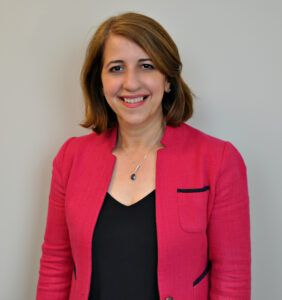 Thankfully, organizations like RBC have several initiatives in place to ensure we are closing this gap – from educating young women and launching partnerships like CanHack with the DMZ, to looking inwards at the organization’s hiring practices to ensure there are diverse individuals represented in tech and leadership roles.
Thankfully, organizations like RBC have several initiatives in place to ensure we are closing this gap – from educating young women and launching partnerships like CanHack with the DMZ, to looking inwards at the organization’s hiring practices to ensure there are diverse individuals represented in tech and leadership roles.
As the Senior Director of Cyber Security Strategic Partnerships and Innovation, May Sarout is working hard to increase the representation of women in Canada’s ever-evolving tech sector. May’s passion for advancing gender diversity and empowering young women in tech is clear; her involvement in initiatives like CanHack, participation in tech events and speaking panels and efforts to raise awareness for more women-identified leaders in cybersecurity are collectively making an impact to tackle the diversity gap.

May shared her insights on the barriers for women in cybersecurity and how young women can get a head start on a successful career in the field. We also asked May what advice she would give tech companies on building diverse teams, and how they can be more intentional about implementing inclusive hiring practices.
Here’s what May had to say.
Why does the cybersecurity gender gap exist?
In my opinion, there are three major reasons why there are fewer women in cybersecurity than there should be. First, there is a huge misunderstanding and misconception about the cybersecurity field, and this leads women to shy away from it. Second, there is a lack of understanding of the variety of roles within cyber, which I will speak to a little later. Lastly, when reviewing job roles, women are generally less likely than men to apply for jobs where they don’t meet every single qualification on a job description – making the number of women in an applicant pool even smaller.
How do we address this gap? What can we do to fix it?
I have a few suggestions, and RBC is already working to address all of them. The first thing we can do to address this issue is create programs that are specifically catered to women.
Another thing we can do to address the gap is to invite more successful women role models to share their journeys on speaking panels and events. This allows younger women in the audience to envision themselves in a similar leadership position and reassures them that they too can be successful in the field. Further to that, it’s important the outreach to young women is there so that they are aware of these events and opportunities in the first place.
We need to be sharing more information about the variety of roles in Cybersecurity. The more that women know about available roles, the more likely they may see themselves in a role.
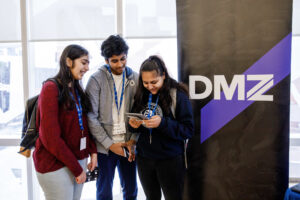
For the young women-identifying innovators who might be interested in exploring a career in cybersecurity but aren’t sure what their options are, what could a career path in this field look like?
There are so many different paths to take!
On one hand, some career paths may take a more technical route. But on the other hand, some Cyber roles require no technical skills. Effective cybersecurity is about more than the technology alone. We need people in cybersecurity that have a thorough understanding of human behaviour and can take a psychological approach to reducing cyber risk.
There are also roles that are involved in the marketing, education and awareness around cyber, and these roles may require little to no technical skills. These roles might require some domain knowledge, but it’s more important the individual has a marketing or communications background than cyber.
Finally, many roles fall in the middle of this spectrum, including project management, business analysis, quality assurance – every cyber organization needs these roles, and these skills can be transferable from other fields in tech. As long as you have the passion for cybersecurity space, you will likely find a role that’s right for you!
How can young women get involved in cybersecurity early?
There are plenty of initiatives that allow youth to have fun as they learn about cybersecurity. CanHack, the initiative we host in partnership with the DMZ, is a great way for young women to get involved early. It’s a fun challenge that helps participants think critically and use problem-solving skills. Hackergal is another great organization that has opportunities designed especially for girls.
There are also lots of business associations catered to women in cyber that you can get involved with, such as Women in Cybersecurity. Leading Cyber Ladies is another one to check out. Take a look at LinkedIn, there are always events going on related to the industry.
The good thing about the days we’re living in now with virtual events is that you’re not restricted to attending events just in your local area. The world has become much more global, and in a way, it’s opened up more doors!

What advice do you have for tech companies that want to adopt more inclusive practices?
Study after study shows that diverse and inclusive teams are more successful. When it comes to diversity, we shouldn’t focus solely on gender diversity. We should look at all diverse talent, whether it’s gender-based, culture-based, age-based, or experience-based.
The advice I would give to companies would be to set certain goals related to diversity and inclusion. Be mindful of what you want to achieve. Declare diversity and inclusion in your performance targets and make sure you track it and measure it on a consistent basis. Diversity and inclusion have to be prioritized.
It’s important to have diversity and inclusion measures within your hiring process. For example, at RBC we ensure that there is diversity in all teams and across all levels of the organization. Hiring managers must report on how many diverse candidates they interview and whether their chosen candidate was a diverse hire.
Beyond setting targets, it’s also important to make sure you have a culture that fosters diverse hiring. If you want to hire more Black, Indigenous, or People of Colour, you must include members of those communities in the recruitment process. This will allow job candidates to see that they have a place in your organization and feel more passionate and confident about the selection process.

How does your team at RBC take measures to address the gender gap issue that exists in the cybersecurity field?
The purpose of the Cybersecurity Strategic Partnerships and Innovation team is to be a major catalyst in growing and lifting cybersecurity talent, thought leadership and innovation in Canada. We do this by growing the cybersecurity talent pipeline, training programs, advocating for diversity and increasing diversity of available talent, increasing interest of future generations in cyber.
First, we’re addressing the cybersecurity gender gap through RBC’s internal recruitment processes. This is prioritized for all areas of the organization at the Executive Committee level. Our Senior Vice President of Cyber Security is a woman – Laurie Pezzente (who has won Canada’s Most Powerful Women – Top 100 award, among several other awards). Additionally, two of the four Executives reporting to our SVP are also women.
RBC is constantly being recognized for its diversity and inclusion initiatives. It’s not just cybersecurity, either – RBC is focused on promoting diversity in all fields.
We partner with organizations like Ryerson and the DMZ on initiatives such as the Cybersecure Policy exchange and CanHack. We’ve also built the RBC Women in Cyber stream within the Rogers Cybersecure Catalyst.
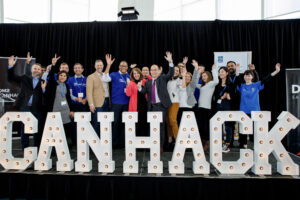 This year, for CanHack 2021, we set specific targets to increase women’s representation.
This year, for CanHack 2021, we set specific targets to increase women’s representation.
Not only will CanHack be offered to Canadian students coast-to-coast, but CanHack 2021 will also be special in that DMZ will run women-only workshops on a number of cybersecurity topics to support women in STEM, and work with organizations like Hackergal to inspire and recruit more female participants to the challenge.
—
Calling all Canadian high school teachers and community supervisors! Would you like to learn more about CanHack and other cybersecurity opportunities for women?
Register here to learn more about the 2021 CanHack Challenge.
Join us for the Women in Cyber panel, hosted by CanHack & Hackergal on Wednesday, November 18 at 5:00pm. Register here.
The panellists will share their experiences as women who are making an impact in the field and address how to collectively create better pathways for women in cybersecurity in Canada.
Questions related to CanHack? Reach out to Naveed Tagari at naveedtagari@torontomu.ca.
How to pivot with purpose: A Q&A with Hop In’s CEO
Hop In’s CEO and Co-Founder, Erich Ko, proves why adaptability is key to entrepreneurial growth
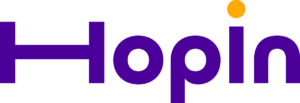
Hop In is a DMZ Incubator company that provides logistics software services to offer customized corporate shuttle solutions for the daily commute. The startup helps companies retain more talent and access a larger hiring pool while providing employers with a comfortable and efficient commute to work.
Erich Ko is the CEO and Co-Founder of Hop In. What started as a business idea discussed between a few friends has evolved into a startup with a real purpose: to improve economic development issues and make transportation more accessible for workers everywhere.
We asked Erich about what fuelled his interest to become an entrepreneur, his experience in the Startup Certified program, how Hop In was conceptualized and how the company has pivoted its strategy this year.
Here’s what he had to say.
Let’s talk about your personal entrepreneurial journey. When did you join Startup Certified? How did you hear about it?
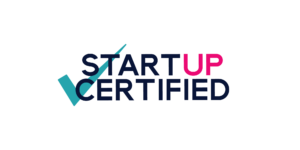 I was a student working at Ryerson’s Legal Innovation Zone Law Practice Program in the same building as the DMZ. By working at the front desk, I was introduced to startups, and through that, I was connected to the Sandbox.
I was a student working at Ryerson’s Legal Innovation Zone Law Practice Program in the same building as the DMZ. By working at the front desk, I was introduced to startups, and through that, I was connected to the Sandbox.
Natasha, Sandbox’s then-Director, introduced me to the Startup Certified program. It seemed really cool and had a structured approach. I joined in the Fall of 2017 and wanted to learn as much as I could!
I joined a startup called Curexe at the time. They have since been rebranded as Cevnn Payments.
What was your role within the startup? What areas of the business were you working on?
It started as a marketing role, and I worked on content marketing and organic growth. However, there were only three of us at the time, so I did everything and anything and developed my skills that way.
After that placement was complete, I ended up going back to consult with them for a few months. I helped them grow the team and scale up a little bit as well.
What made you interested in pursuing entrepreneurship?
 Before that placement, I had been working for the government for six years. I ran into the “red tape” problem – something that you hear about, but don’t believe it until you see it. I figured that there has to be a faster way and a better way for me to have an impact. I turned to startups. It seems to really be the best way to change something in the world.
Before that placement, I had been working for the government for six years. I ran into the “red tape” problem – something that you hear about, but don’t believe it until you see it. I figured that there has to be a faster way and a better way for me to have an impact. I turned to startups. It seems to really be the best way to change something in the world.
I’ve also been restless my entire life! I got in a lot of trouble as a kid and I was doing some things I wasn’t supposed to. Entering the entrepreneurial world helps you channel that energy. I know it sounds cliche, but it really does.
I can work 40-50 hours straight without sleeping and nobody will say anything (besides my mom!) You’re constantly solving problems; it’s challenging. You never know what the day holds for you, so this was the perfect fit for me.
This, I know, is what I’m going to do with my life.
Let’s talk about Hop In. What was the story behind creating the company?
I actually grew up with my two co-founders! One of them is my best friend, and our CTO was my brother’s best friend growing up.
One night while drinking at the bar, we were discussing how we had all lived every problem possible when it came to commuting. That’s when we decided we would try to build an app to solve commuting issues.
Fast forward to today, we’ve snowballed into a bigger problem that we didn’t even know was there in the beginning. There’s a huge economic development issue that is the root of these commuting problems.
There are these gaps left behind by transit in areas that are outside of the Torontos of the world. Workplaces in these areas aren’t always accessible. We provide a last-mile solution to connect them from the transit system to the workplaces.
We also realized recently that we can help people from marginalized communities and the shelters, so we are actually working on different job programs to help people get access to better opportunities that they normally wouldn’t have.
Hop In provides more than just transportation – can you explain how Hop In helps employers?
 We help companies expand their hiring pools. One of our companies is Maple Lodge Farms in Brampton. We helped them hire their first employee from Scarborough, which is really not a possible transit route if you don’t have a car, right? That’s the value we add to the companies.
We help companies expand their hiring pools. One of our companies is Maple Lodge Farms in Brampton. We helped them hire their first employee from Scarborough, which is really not a possible transit route if you don’t have a car, right? That’s the value we add to the companies.
We go to a company and do a needs assessment for free. Employees tell us all about their commutes and schedules. Then, we plug that information back into our internal software system and design customized routes and schedules based on the employees’ needs.
If employers have issues with retention, it’s something that Hop In can also help with. The employer usually covers the cost completely.
We work very closely with recruitment agencies and staffing agencies. We’re members of the Brampton Board of Trade as well and work closely with all the bodies that contribute towards the development of a city, development of commercial properties, and management of all of those work sites. Hop In works with everybody in that spectrum.
Our operations are primarily based in the York Region, but currently, we are working on programs with 107 municipalities across Ontario! Our main areas are GTA-focused, and now we are getting out to the rural areas and small towns.
How does the shuttling aspect of Hop In work?
We work with chartered bus companies that normally do events. For them, working with us is a no-brainer. It’s a new stream of revenue for them, especially during COVID as no one is going to events.
With our bus operators, we are constantly looking at data: tracking rides and optimizing routes. For example, if there were a Raptors game or Leafs game or a parade, we can reroute instantly.
The bus companies we work with are also certified to provide accessible transportation for people with disabilities. We just finished up a pilot with Durham Deaf Services to transport their learners to the facilities.
You mentioned that there has been less of a demand for bus services due to COVID-19. How has the pandemic changed how you operate?
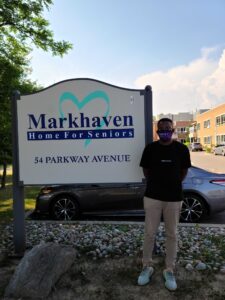 For the first couple of months, everyone was just trying to figure out their place in this world now. We took that time to help those in need. We realized we weren’t going to generate revenue for at least a few months, so we figured we might as well do something productive with the time and help out.
For the first couple of months, everyone was just trying to figure out their place in this world now. We took that time to help those in need. We realized we weren’t going to generate revenue for at least a few months, so we figured we might as well do something productive with the time and help out.
Hop In paired up with restaurants in Vaughan, Markham, and Brampton and we delivered around 100 meals and free rides to work for healthcare workers. We’ve actually now donated over 20,000 disposable masks across Canada!
We also had to shift the focus of our customer demographics. We had been working with tech companies, but they all started to work from home, so we doubled down on the essential factories and manufacturing facilities that had to stay open.
We did pivot, but nothing too big for us. Our core model stayed the same.

What advice would you give other university students or other aspiring entrepreneurs if they want to start a business?
I have three things. The first one is you just got to go for it. It’s going to be tough, things don’t always go as planned.
If it’s something you really want to do, then there are a lot of opportunities and you can find help from places like the DMZ. The DMZ taught me so much about design thinking – that was the biggest thing for me to understand how to actually validate this thing!
My second piece of advice is to listen to your customers. I really didn’t understand this point until last year. Build what your customer needs – not necessarily what sounds nice.
The last thing? It’s all about perspective. Especially during times like this – with COVID and the economic crisis happening at the same time – there is always a way. The situation that we’re in is creating a host of problems, but the reason why we exist as entrepreneurs is to solve problems.
A lot of people thought we were dead because we are a transportation company, but we pivoted and we became an essential service to a lot of industries. In times like these, take a look from every different angle and make sure you leave no stone unturned.
I’ll be honest… we are not without our freakouts! But it’s been really, really fun because we’ve just been throwing pasta at the wall and seeing what sticks, right? Every day we are throwing something new out there to see what happens. It’s been kind of fun experimenting that way.
Want to learn more? Visit Hop In’s website and follow them on LinkedIn, Twitter, Instagram and Facebook.
6 women founders who are building game-changing tech
Hear what inspired these up-and-coming tech CEOs to take the leap into entrepreneurship.
What’s it like being a “parentpreneur” during the pandemic?
For parent founders working full-time from home, managing a company while raising kids has been one of the more trying aspects of the pandemic.
Between handling screaming children while on conference calls at home and dealing with the stress of sending kids back to school, parents with young children haven’t had it easy this pandemic. Remote working as a result of COVID-19 has greatly affected life at home as we know it, and in some cases, has completely changed family dynamics and parenting styles.

Most entrepreneur parents, or “parentpreneurs”, have the privilege of working from home, even in the absence of a pandemic. That doesn’t mean keeping kids home for remote learning has been easy.
DMZ founders share their experiences while working from home with kids. Inevitability, there have been challenges – but parents have also seen some surprising silver linings come out of it.
If you’re a parent in a similar situation, you might find comfort in hearing that no family has perfected life during a worldwide pandemic. Hear what these founders are saying!
The switch to distance learning and remote working
 Tweepsmap’s Samir Al-Battran, Founder & CEO and Erin Heywood, Manager of Operations, are a parent duo with three school-aged children. As soon as the pandemic hit in March, Tweepsmap had already begun remote work. Samir and Erin felt prepared ahead of their school’s shutdown and, all things considered, were appreciative of their situation as parents.
Tweepsmap’s Samir Al-Battran, Founder & CEO and Erin Heywood, Manager of Operations, are a parent duo with three school-aged children. As soon as the pandemic hit in March, Tweepsmap had already begun remote work. Samir and Erin felt prepared ahead of their school’s shutdown and, all things considered, were appreciative of their situation as parents.
“We’re lucky. Not everyone has the luxury to work from home or has a business that can continue without much disruption,” explains Erin. She adds that it helps that her children have two tech-savvy parents and enough devices in the home to make distance learning physically possible for three kids in one household.
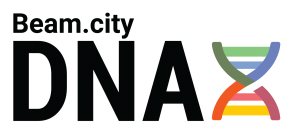 Zeze Peters, Founder & CEO of Beam.city is also a parent of three: two school-aged children and a newborn. He claims that parenting during the pandemic has been both amazing and tricky – something that many parents can relate to: “Before COVID, my wife and I were complaining that we didn’t have enough time to spend with our kids. Mid-school year, we got our wish – but not on great terms.”
Zeze Peters, Founder & CEO of Beam.city is also a parent of three: two school-aged children and a newborn. He claims that parenting during the pandemic has been both amazing and tricky – something that many parents can relate to: “Before COVID, my wife and I were complaining that we didn’t have enough time to spend with our kids. Mid-school year, we got our wish – but not on great terms.”
Balancing work and family life
 Kate Mansouri, Founder & CEO of Pennygem has had her hands full in 2020. For Kate, it’s been a year of firsts – she’s growing her first startup and has become a mother for the first time. Most of the Pennygem team consists of women that have children, so as a leader, Kate has been understanding of parenting struggles during a pandemic.
Kate Mansouri, Founder & CEO of Pennygem has had her hands full in 2020. For Kate, it’s been a year of firsts – she’s growing her first startup and has become a mother for the first time. Most of the Pennygem team consists of women that have children, so as a leader, Kate has been understanding of parenting struggles during a pandemic.
“It’s been tough for them. Sometimes parents are sitting in a meeting, their kids walk in and ask a million questions and they have to turn the camera and microphone off to attend to the kids. It can be tough to stay on track and be productive having your kid around,” Kate explains. “I, myself, have to wake up at 5:00 a.m. every day. My most productive times are from 5:00 a.m. to 7:00 a.m., and then in the evening when my baby goes to bed.”
For Samir and Erin, working for the same company has both its benefits and drawbacks. “The challenge is that kids are screaming while you’re trying to have a call with a customer, so it’s been different – and Erin can’t work as much as she could before because she’s taking a lot of the load from our children being at home.”
Zeze’s sentiments are similar, stating that client meetings and managing a team has been a little tricky with the kids home from school. “Sometimes they’ll come in and join my meetings, which actually doesn’t always bother me, but it does break your workflow. There’s a concept in technology called context switching: going from business work to funding work, to team management work, writing technology, to responding to emails and then, of course, dealing with kids. A context switch takes your mind from one mode to another mode. Working from home, my daily productivity went through the floor. As an early-stage startup, every hour matters, especially when I’m leading a team,” Zeze says.
Plans for this school year
In August, provincial governments and school boards across the country began announcing plans to send kids back to the physical classroom this fall for the 2020-2021 school year. The COVID-19 pandemic posed yet another dilemma for parents. While at-home work productivity would surely improve, the potential spread of the virus amongst kids is something parents have to take into consideration.
While Kate has a newborn baby and doesn’t yet have to make a decision on whether to send her child to school, she knows most of the parents on her team have found it difficult balancing family and work life, and will likely be opting to get kids back into a routine. “I think [the parents] would be taking the option of having kids go back to school. It’s been very tough on some of them. Many moms are looking for ways to take their children back to daycare or school, even if it’s part-time,” Kate explains.

Erin and Samir say they’ve made the decision to keep their three kids home for remote learning, at least for the start of the year. Erin mentions that, in continuing remote learning, there will be bumps in the road – but it won’t feel like the same emergency it was in the Spring for her three kids. “The school has a set mandated time for teacher-led learning every day. The kids will have to be in front of a computer, and some people are complaining about screen time – but frankly, this is the choice you’re making for your child if you decide to keep them home.” Erin also says that if class sizes were smaller, they would consider sending their children back to school. But with potentially 25-30 in a classroom, there won’t be much physical distancing.
Samir mentions that the decision to keep kids home will help with the consistency of their learning. “We’re thinking about sustainability. If things get bad again and schools shut down, it would be disruptive to their school year. If we get them online from the beginning, at least they will have more stability in their learning.”
Zeze and his wife have also opted to keep their two school-aged children in the virtual classroom for now. “As good as the intention is to have teachers bear the brunt of the cleanliness for large periods of the day, it’s just hard to be perfect,” Zeze explains. “There are hundreds of kids. With COVID, even though small kids may not have strong symptoms and develop issues, it may not be the same for their parents and grandparents.”
In it for the long haul? Parenting WFH tips and silver linings
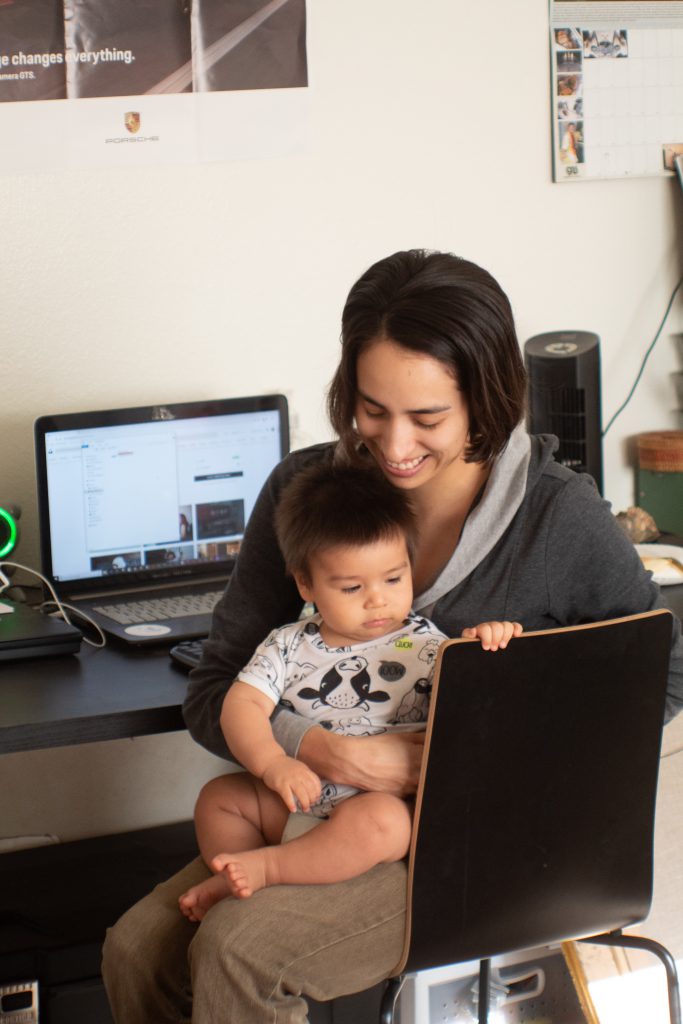 As the digital workplace and classroom may very well be our reality for the next while, we asked founders if they have tips to offer other parents for improving work-life balance and family dynamics in the current environment. Parents also explain that amidst the pandemic, they have seen some benefits to keeping the family at home – and have been embracing the silver linings that have come with it.
As the digital workplace and classroom may very well be our reality for the next while, we asked founders if they have tips to offer other parents for improving work-life balance and family dynamics in the current environment. Parents also explain that amidst the pandemic, they have seen some benefits to keeping the family at home – and have been embracing the silver linings that have come with it.
Erin and Samir are grateful that they even have the ability to work from home and spend more time with the family. In terms of tips for keeping the family happy and productive, Erin adds: “Each case is different, every child is different. You can’t listen to what everyone is telling you. Try to come up with a solution that works for your own kids, your company and your life. It’s important to listen to your kids and what their needs are.” As an example, given the government’s social bubble restrictions, Erin and Samir have been flexible with allowing their daughter to spend more time than usual socializing with friends online.
A practical solution for Zeze’s family was to establish a consistent daily routine in which his kids finished school work first thing in the morning. “Before they did anything else, they had to get their school work done early in the morning. By about 10:00 a.m., they would be done for the day. My wife and I could get back to being productive with our own work.”
As a founder whose team has been working in a digital format since the company’s inception, Kate doesn’t plan to bring her startup into an office setting post-pandemic – at least not full-time. Her team sees great value in Pennygem’s remote working policy.

Kate explains that some mothers on her team have appreciated the extra bonding time at home with children. “My hope is to provide them with an opportunity to have meaningful input, but at their own convenient time. It’s working really well for us. We’re very flexible,” Kate adds. “The situation was a big eye-opener for a lot of people. We were required to work from home all of a sudden, and many of us have discovered that it’s working. It’s tough, but you learn to work around it.”
Zeze adds that a silver lining to this crisis has been that his family is making special memories that they will cherish forever. “The kids have picked up arts and crafts, they paint now too. We’ve been having barbecues together, we’ve built a farm full of fruits and vegetables which the kids have helped plant and harvest. Every day when they go out to play, it’s cool to look out the window and see them playing in the backyard. It makes us feel happy.”
If you’re a parentpreneur working from home with kids, share your experiences and tips with the DMZ on Twitter, Instagram and LinkedIn!
The difference a decade can make: DMZ turns 10
10 years, 477 startups, 4,142 jobs created, $916.4M raised and counting…
2020 marks a huge milestone for the DMZ. It’s a big anniversary – we’ve officially been around for a decade. We’ve transformed from a small student coworking space to a world-leading incubator-accelerator, and to celebrate this birthday we’re taking a trip down memory lane to reflect on the accomplishments, challenges and victories the DMZ has seen since our inception. Most importantly, we want to highlight the people who have pivotal roles in shaping what the DMZ is today.
We’re giving away a Nespresso machine + more to celebrate 10 years!
Check out the DMZ Instagram to participate in our trivia and giveaways over the next two weeks. Starting on Wednesday, September 16, we’ll be giving away a brand new Nespresso Vertuo Coffee & Espresso Machine, exclusive DMZ swag and a copy of the #1 Bestselling book Good to Great by Jim Collins. Since you’re already reading this blog, you’ve got a head start – you may just find some trivia questions here! Follow us now to ensure you don’t miss a post.
DMZ’s biggest milestones over the last decade

The DMZ is born.
A student founder from Soapbox pitched an idea to Sheldon Levy, Toronto Metropolitan University’s then-President. The student needed support in developing an idea for a new startup company and couldn’t find the help they needed on campus. Sheldon Levy saw the potential to create an innovative space for students to work on new business ideas, and together with co-founders Valerie Fox and Dr. Hossein Rahnama, the Digital Media Zone was born!

Open for business.
Within one year of opening, the DMZ had already garnered significant interest within the entrepreneur ecosystem. In 2011, the DMZ’s first Executive Director and Co-Founder, Valerie Fox, made a decision that would transform the Digital Media Zone: opening our doors to founders outside of the Ryerson community. As the number of founders joining the DMZ grew, the physical space grew with it and expanded two extra floors to accommodate incoming companies.
DMZ Co-Founder, Dr. Hossein Rahnama was the first to commercialize his research at the DMZ and founded Flybits – a startup that went on to become one of Canada’s top AI companies.

Royalty arrives at the DMZ.
It’s true! In 2012, His Royal Highness Prince Charles paid a visit to the DMZ while on a Canadian tour. The Prince made his way through the DMZ’s offices at Yonge-Dundas square and student entrepreneurs were given the opportunity to showcase their companies, drawing the royal member’s attention to the talent and innovation being incubated at the DMZ.
In 2012, Carrie-Ann Bissonnette, Manager, helped build processes and rigger that shaped the foundation of the DMZ in its early days.

A new investment arm & visit from Justin Trudeau.
As early-stage DMZ startups began transforming into high-growth companies, Toronto Metropolitan University launched Ryerson Futures Inc. (RFI), a for-profit investment arm and startup accelerator that could provide companies with seed financing to help them grow to significant value. This year, we announced RFI’s rebrand to DMZ Ventures.
In 2013, the DMZ received yet another high-profile visit. This time, it was Justin Trudeau that stopped by to get a tour of the newly-expanded, five-floor DMZ incubator during his federal Liberal leader election campaign that year.

Launch Zone opens.
Now known as DMZ Sandbox, the former Launch Zone opened its doors in Ryerson’s brand new Student Learning Centre as an on-campus space to help students looking to explore the world of entrepreneurship. More than six years later, DMZ Sandbox continues to help the next generation of aspiring entrepreneurs turn their ideas into real businesses.
$63.1M capital raised by DMZ startups in 2014

New name, new leadership, new global title.
2015 marked a turning point for the Digital Media Zone. Over five years, the technology being incubated at the DMZ shifted and the majority of startups were no longer considered to be within the digital media field. The Digital Media Zone announced an official rebrand to “DMZ”, signalling it had become sector-agnostic.
In July 2015, the DMZ saw another big change – Abdullah Snobar took over the role of Executive Director. From the start, Abdullah invested in rebuilding the DMZ so it offered more functional workspaces, better communal areas to host events and investor meetings, and home-like amenities to build a comfortable environment for founders spending long hours on their startups. Under Abdullah’s leadership, the DMZ began putting dedicated resources into expanding its program team. DMZ’s offerings expanded to include more hands-on coaching, vibrant community events, support with customer acquisition and giving startups better access to capital. Revamping the program structure and creating a “founders first” environment ultimately led the DMZ to earn the title of the top incubator in North America by UBI Global!
$68.2M capital raised by DMZ startups in 2015

The first Advisory Council.
As the DMZ continued to evolve its growth strategy, its next big move involved launching the first Advisory Council in 2016. Formed to help build the strongest startup community in the world, the Council members would go on to promote the DMZ in the broader business community and advise the DMZ on matters such as strategic direction, international growth, fundraising, industry trends and more. To this day, our Advisory Council nurtures the DMZ’s connection with the business community.
$77.1M raised by DMZ startups in 2016

DMZ opens a leading growth accelerator.
In 2017, the DMZ launched its very first accelerator cohort to help entrepreneurs innovate faster and achieve hypergrowth. Three years and 13 cohorts later, the DMZ’s most competitive program has received world recognition.
That year, DMZ also gave Canadian tech startups a new place to call home south of the border and opened a new office space in the heart of New York City’s financial district, making the DMZ the first Canadian university incubator to open an office in the U.S.
$168.6M raised by DMZ startups in 2017

#1 in the world.
In 2018, UBI Global ranked The DMZ as the number one university-based incubator in the world. UBI Global is a leader in performance analysis of business incubators around the world. The Stockholm-based research organization looks at over 20 key performance indicators to determine rankings.
That’s not all for 2018! DMZ was given yet another prestigious title by Waterstone Human Capital and was named as one of Canada’s Most Admired Corporate Cultures, affirming the DMZ’s core values as an organization: -‘equity over everything’, ‘founders first’ and ‘be great’.
$197.7M capital raised by DMZ startups in 2018

Game-changing programs and work culture.
Last year marked another year with many firsts for the DMZ. In 2019, we launched two brand new programs that both took a customized, founders-first approach. The first, DMZYYZ, launched a two-week soft-landing program that gave elite international entrepreneurs a personalized ticket into the North American market, fueling business integration with other global markets. The second being the Black Innovation Fellowship – a first-of-its-kind initiative in Canada aimed at breaking down barriers Black founders face, helping them scale their companies to the next level.
$189.1M capital raised by DMZ startups in 2019

10 years, 477 startups, 4,142 jobs created, $916.4M raised in total.
Between a global health crisis and economic downtown, it’s no secret the last six months of this year have brought pain, heartbreak and struggle for many in our community. The business landscape, in many ways, has completely transformed – but as a result, we’ve found some powerful silver linings.
The DMZ community thrives off of building strong in-person connections, but moving to a virtual environment has opened new opportunities for our startups and programs. We’ve been able to connect more extensively with founders, partners, and opportunities around the world. Virtual programming has allowed us to expand our offering to international companies, and we’re now serving (and accepting applications from) startups worldwide.
In the last six months alone, we: transformed our programming to run our Incubator and Accelerator virtually, helped international companies integrate into the North American market through the DMZ YYZ program, launched the #HackTheCurve challenge, hosted government calls advocating for startup COVID-19 support, had several student entrepreneurs go through our Startup Certified and Basecamp programs, provided dedicated programming for Black entrepreneurs (Black Innovation Fellowship Pre-Incubator) and women-led startups (Women Founders Fast Track pilot), joined industry leaders to establish the Innovation Economy Council, launched DMZ Innisfil to drive innovation in rural Ontario, introduced new international programs (shh… stay tuned!) and announced DMZ Ventures – a move that allows us to offer a full spectrum of startup support at every stage – from business ideation to investment.
That’s just a quick snapshot of what we’ve got going on – it’s been a busy year, but we won’t stop here.
DMZ’s vision is to see a world powered by ambitious entrepreneurs. In these times, we pledge to do whatever it takes to help our tech startups push past barriers to growth and transform into world-class organizations.
Thank you to everyone who’s helped the DMZ become what it is today – the late Raymond Chang, Valerie Fox, Dr. Hossein Rahnama, Sheldon Levy, and Mohamed Lachemi, current President and Vice-Chancellor of Toronto Metropolitan University, just to name a few. An immense thank you to all of our incredible startup founders and their teams, all of our coaches, advisors, partners, and staff – cheers to the next decade of building great Canadian tech companies.
We can’t wait to see what the next 10 years hold.
Are you a startup founder interested in learning more about DMZ’s programs? Reach out at dmz@torontomu.ca!

